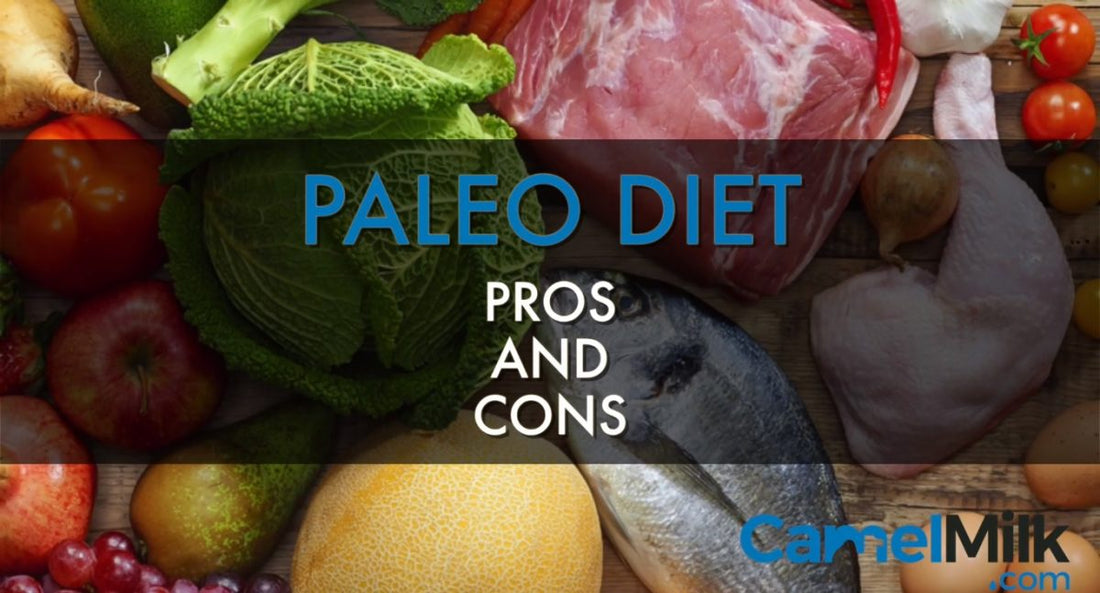One of the most popular diets of late — the Paleo diet — is actually hundreds of thousands of years old. Nicknamed the Caveman Diet, this diet focuses primarily on the foods that our Paleolithic ancestors ate.
Those who advocate the Paleo diet swear by its many health benefits, from weight loss to increased energy and clearer skin. However, this primal diet receives mixed reviews from nutritionists and scientific research alike.
Read the Paleo diet pros and cons below to determine if this diet is right for you.
What is the Paleo Diet?
The Paleo diet is inspired by a hunt-and-gather meal plan. If a caveman didn’t eat, neither will you. The diet focuses on eating natural, unprocessed food. It eliminates sugar, wheat, and processed foods and favors meat, fruit, vegetables, nuts, and healthy fats.

Calorie counting is discouraged on the diet. Generally, a Paleo diet is high in fat, moderate to high in animal protein, and low to moderate in carbohydrates.
Quality, grass-fed meat is recommended alongside seafood, eggs, fresh fruit, vegetables, leafy greens, nuts, seeds, and healthy fats and oils.
Foods to Avoid on Paleo
The Paleo diet avoids sugar, grains, dairy, legumes, processed foods, and vegetable oils. Those who follow a strict Paleo diet also avoid alcohol and potatoes.
Since our Paleolithic ancestors were hunter-gatherers, and not farmers, all wheat, grains, and dairy are avoided. Although dairy is in the “grey zone” of the Paleo diet, some allow organic, grass-fed, or even raw dairy.
All forms of refined sugar are ditched from the Paleo diet. No soda, candy, baked goods, fruit juices, or desserts are allowed. Besides the Paleo diet being gluten and wheat-free, it is also free from all grains. This includes spelt, rye, barley, and rice. Pseudo-grains such as quinoa, buckwheat, and amaranth are also avoided.

In addition, legumes (such as beans, peanuts, and lentils), oats, vegetable oils, margarine, trans fat, and artificial sweeteners are also banned from the Paleo diet. Processed foods are also excluded. In general, any food that comes out of a box will be avoided.
Although most meats receive the green light on the Paleo diet, processed and cured meats are restricted. This includes most deli meats, bacon, sausages, hot dogs, salami, or jerky—which are often made with sugar, soy, salt, corn syrup, dairy, and preservatives.
Pros of the Paleo Diet
The Paleo diet is one of the most controversial diets among nutritionists and health specialists. While there are many pros to this primal way of eating, there are also just as many flaws.
Our modern diet today is not the best. We eat more processed foods than ever before, and the American diet is rich in high-calorie and unhealthy foods such as soda, baked goods, pizza, and alcohol. Our ancestors certainly got some things right when it came to their diet. They consumed more fiber, protein, produce, and vitamins; and consumed less saturated fat and sodium.
Most nutritionists agree that the Paleo diet has many great qualities, including placing an emphasis on consuming more:
- Whole foods
- Fruits
- Vegetables
- Healthy fats
- Lean proteins
However, many have an issue with the “off-limits” portion of the Paleo diet, including fiber-full and heart-healthy whole grains, beans, and even dairy.
Cons of the Paleo Diet
As far as the “cons” category of the Paleo diet goes, backlash and criticism state that the diet is unrealistic, too restrictive, unbalanced, or lacking in scientific research.
One main drawback is the fact that many of the Paleo diet’s “banned” foods are proven to be good for your health. Whole grains, for example, are linked to lower mortality rates and lower your risk of heart disease, stroke, diabetes, and obesity. Legumes, such as beans, are high in fiber, protein, and nutrients. Dairy is the primary source of vitamin D and calcium in modern diets, crucial to bone health and the prevention of osteoporosis.
Furthermore, there is no “one-size-fits-all” diet when it comes to our Paleolithic ancestors. Different regions of the world had different diets and ate what was available to them. Many dieticians argue that our digestive system has greatly evolved since our Paleolithic ancestors and it’s unnecessary, even harmful, to cut out certain healthy food groups.
The Paleo diet is also not a feasible choice for everyone. Since the diet encourages organic, grass-fed products and places emphasis on meat, the Paleo diet is fairly expensive. It also requires a large amount of prep work and time. The Paleo diet is also difficult for vegetarians (and nearly impossible for vegans) and can be difficult for endurance athletes due to low carb intake.
However, there are many benefits to the Paleo diet as well. The primal diet focuses on whole, natural, and organic foods. Any diet that eliminates refined sugar and overly-processed foods is generally considered beneficial. The diet is low in sugar and sodium but high in fiber, protein, and potassium.

Since fast or processed food is not an option on the Paleo diet, it forces you to cook your own food. Studies show that people who cook most of their meals at home consume fewer calories, fat, and sugar and are generally healthier. Since it does concentrate on organic produce and grass-fed meats, the Paleo diet stresses quality, sustainability, and overall nutrition.
Studies (particularly short-term) have also shown that a Paleo diet can lead to a more favorable BMI, weight, waist circumference, and blood pressure.
Is the Paleo diet right for you? What are your thoughts on this primal diet? Tell us in the comments below!

 Log in
Log in
